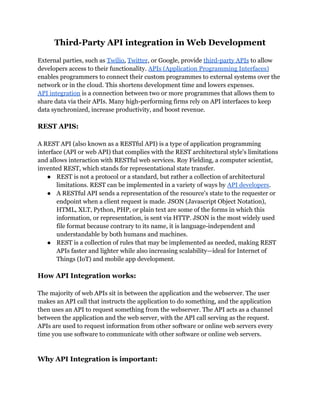
Third party api integration
- 1. Third-Party API integration in Web Development External parties, such as Twilio, Twitter, or Google, provide third-party APIs to allow developers access to their functionality. APIs (Application Programming Interfaces) enables programmers to connect their custom programmes to external systems over the network or in the cloud. This shortens development time and lowers expenses. API integration is a connection between two or more programmes that allows them to share data via their APIs. Many high-performing firms rely on API interfaces to keep data synchronized, increase productivity, and boost revenue. REST APIS: A REST API (also known as a RESTful API) is a type of application programming interface (API or web API) that complies with the REST architectural style's limitations and allows interaction with RESTful web services. Roy Fielding, a computer scientist, invented REST, which stands for representational state transfer. ● REST is not a protocol or a standard, but rather a collection of architectural limitations. REST can be implemented in a variety of ways by API developers. ● A RESTful API sends a representation of the resource's state to the requester or endpoint when a client request is made. JSON (Javascript Object Notation), HTML, XLT, Python, PHP, or plain text are some of the forms in which this information, or representation, is sent via HTTP. JSON is the most widely used file format because contrary to its name, it is language-independent and understandable by both humans and machines. ● REST is a collection of rules that may be implemented as needed, making REST APIs faster and lighter while also increasing scalability—ideal for Internet of Things (IoT) and mobile app development. How API Integration works: The majority of web APIs sit in between the application and the webserver. The user makes an API call that instructs the application to do something, and the application then uses an API to request something from the webserver. The API acts as a channel between the application and the web server, with the API call serving as the request. APIs are used to request information from other software or online web servers every time you use software to communicate with other software or online web servers. Why API Integration is important:
- 2. 1. An API is a component that enables different platforms, applications, and systems to communicate with one another, share information, and perform a variety of functions. 2. APIs make integration easier by allowing different applications to restructure their interrelationships based on your company's individual needs. 3. Integrations automate repetitive operations, resulting in a seamless transition between linked applications. Your company may save money, time, and effort by automating and integrating procedures. 4. APIs make it easier to build new apps, business models, and digital products, and they enable successful integration with third-party products and services. 5. APIs are necessary for digital transformation as well as the design and development of new business models. They serve as the foundation for application economics, which may be built more quickly, more effectively, and at a lesser cost. How to build API: 1. Form internal teams and gather resources: What other tools and procedures will I require to complete this integration? 2. Examine each system's schema (the relationships between data): How can I establish new connections between these systems to ensure a smooth data transfer? 3. Integrating and testing the system 4. Monitoring the integration's success 5. Outline your integration's business case: What issues will be resolved as a result of this integration? What would the end-experience users be like with the integration? What is the cost of building API Integration: ● Depending on the complexity of the interface and the time investment of your developers, a single API integration can easily cost $10,000 or more.
- 3. ● It's critical to realize that API programming requires more than just writing an application interface. Various factors impact the cost of API, whether a business owner plans to hire an outsource provider or allocate a new project to an in-house team.